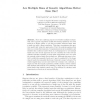Free Online Productivity Tools
i2Speak
i2Symbol
i2OCR
iTex2Img
iWeb2Print
iWeb2Shot
i2Type
iPdf2Split
iPdf2Merge
i2Bopomofo
i2Arabic
i2Style
i2Image
i2PDF
iLatex2Rtf
Sci2ools
GECCO
2003
Springer
2003
Springer
Are Multiple Runs of Genetic Algorithms Better than One?
Abstract. There are conflicting reports over whether multiple independent runs of genetic algorithms (GAs) with small populations can reach solutions of higher quality or can find acceptable solutions faster than a single run with a large population. This paper investigates this question analytically using two approaches. First, the analysis assumes that there is a certain fixed amount of computational resources available, and identifies the conditions under which it is advantageous to use multiple small runs. The second approach does not constrain the total cost and examines whether multiple properly-sized independent runs can reach the optimal solution faster than a single run. Although this paper is limited to additively-separable functions, it may be applicable to the larger class of nearly decomposable functions of interest to many GA users. The results suggest that, in most cases under the constant cost constraint, a single run with the largest population possible reaches a b...
| Added | 06 Jul 2010 |
| Updated | 06 Jul 2010 |
| Type | Conference |
| Year | 2003 |
| Where | GECCO |
| Authors | Erick Cantú-Paz, David E. Goldberg |
Comments (0)

